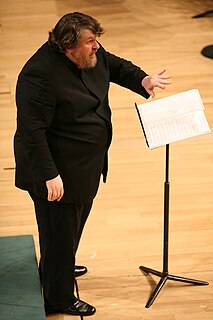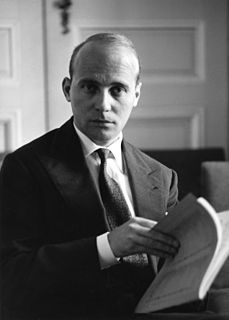Related Research Articles
In musical terminology, tempo is the speed or pace of a given piece. In classical music, tempo is typically indicated with an instruction at the start of a piece and is usually measured in beats per minute. In modern classical compositions, a "metronome mark" in beats per minute may supplement or replace the normal tempo marking, while in modern genres like electronic dance music, tempo will typically simply be stated in bpm.

Juan Leovigildo Brouwer Mezquida is a Cuban composer, conductor, and classical guitarist. He is a Member of Honour of the International Music Council.

Stuart Oliver Knussen was a British composer and conductor.

The Symphony No. 1 in F minor by Dmitri Shostakovich was written in 1924–1925, and first performed in Leningrad by the Leningrad Philharmonic under Nikolai Malko on 12 May 1926. Shostakovich wrote the work as his graduation piece at the Petrograd Conservatory, completing it at the age of 19.

Hans Werner Henze was a German composer. His large oeuvre of works is extremely varied in style, having been influenced by serialism, atonality, Stravinsky, Italian music, Arabic music and jazz, as well as traditional schools of German composition. In particular, his stage works reflect "his consistent cultivation of music for the theatre throughout his life".
The Variations on a Nursery Tune for piano and orchestra, Op. 25, were written by Ernst von Dohnányi in 1914. It is subtitled "For the enjoyment of friends of humor, to the annoyance of others" on the manuscript, though he omitted this inscription on the concert program and on the published edition, fearing that it might sound somewhat provocative. The work was premiered in Berlin on 17 February 1914.
Hans Werner Henze's Symphony No. 1 was premiered in Darmstadt in 1947. The premiere was hit by Henze’s accustomed bad luck. The orchestral parts, handwritten by the composer himself, had become illegible during photocopying in Schott’s offices and despite the young composer’s best efforts to ink in the parts throughout the night, only the slow movement was performed. The whole symphony was eventually premiered a year later, although Henze himself conducted the work only after comprehensive revision.

Leonard Bernstein's Symphony No. 2 The Age of Anxiety is a piece for orchestra and solo piano. The piece was composed from 1948 to 1949 in the US and Israel, and was revised in 1965. It is titled after W. H. Auden's poem of the same name, and dedicated to Serge Koussevitzky.
El Cimarrón is a composition by the German composer Hans Werner Henze, written when the composer lived in Cuba in 1969–1970. It is subtitled Biographie des geflohenen Sklaven Esteban Montejo, and the libretto by Hans Magnus Enzensberger is based on the oral autobiography related in 1963 to Miguel Barnet by Montejo, who was also a veteran of the Cuban War of Independence (1895–98).
Symphony No. 5 by Hans Werner Henze was written in 1962.
The Seventh Symphony by the German composer Hans Werner Henze was written in 1983-84. It was commissioned by the Berliner Philharmoniker as part of the orchestra's centenary celebrations in 1982.
The Eighth Symphony by the German composer Hans Werner Henze was composed in 1992–93.
The Symphony No. 2 in D-flat major, Opus 30, W45, "Romantic", was written by Howard Hanson on commission from Serge Koussevitzky for the 50th anniversary of the Boston Symphony Orchestra in 1930, and published by Carl Fischer Music.
Partita for orchestra, Alla memoria di Ernesto Consolo, is a composition by the Italian composer Luigi Dallapiccola. It was composed between 1930 and 1932.
Heliogabalus imperator, allegoria per musica is an orchestral work by the German composer Hans Werner Henze.
The Boston Concerto is a concerto for orchestra by the American composer Elliott Carter. The work was commissioned by the Boston Symphony Orchestra, for which the piece is titled. It was first performed in Symphony Hall, Boston, on April 3, 2003 by the Boston Symphony Orchestra under the conductor Ingo Metzmacher. Carter dedicated the concerto to his wife Helen Jones Carter, who died on May 17, 2003.
The String Sonata No. 1, commonly referred to by its original Italian name Sonata per archi, is a composition for string orchestra by German composer Hans Werner Henze. It was composed between 1957 and 1958.
Hans Werner Henze's Symphony No. 3 was written between 1949 and 1950. It was premiered at the Donaueschingen Festival on 7 October 1951 by the South German Radio Symphony Orchestra conducted by Hans Rosbaud.
Hans Werner Henze's Symphony No. 4 was written in 1955. It was premiered at the Hochschule für Musik, Berlin on 9 October 1963 by the Berlin Philharmonic Orchestra conducted by the composer.

The Symphony No. 2, Op. 14, is a three-movement orchestral composition by the Swedish composer Dag Wirén, who wrote the piece from 1938–39. Despite its numbering, the Second Symphony represents Wirén's first contribution to the form as a professional. Swedish conductor Sixten Eckerberg premiered the new symphony with the Gothenburg Symphony Orchestra in Gothenburg on 13 October 1940. Although the public received the premiere positively, the critics cautioned that the new work was mildly derivative of Carl Nielsen. At 30 minutes, the Second is the longest of Wirén's four essays in the genre, as well as, stylistically, the most late-Romantic and pastoral of the set.